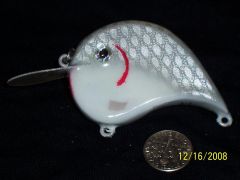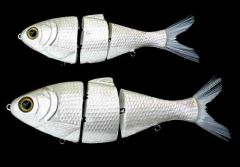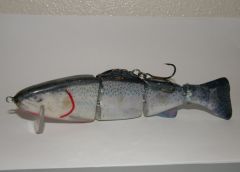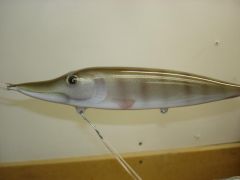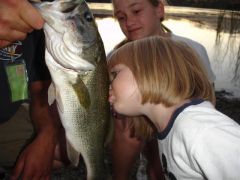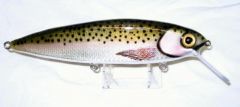-
Posts
3,867 -
Joined
-
Last visited
-
Days Won
23
Content Type
Profiles
Articles
TU Classifieds
Glossary
Website Links
Forums
Gallery
Store
Everything posted by diemai
-
-
-
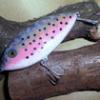
Bull Shad Gizzard/Shiner/Threadfin/Hitch
diemai commented on Triton Mike's gallery image in Hard Baits
-
@ blackjack Don't keep records apart from my design sketches to shape the lures after . I usually make at least two more lures after a proven new prototype , most likely more , and if my stock goes down to only one of a kind remaining , that one strictly stays at home , until I'd be done with some new ones shaped after it and the design sketch . But still they do not all act exactly the same , even when making three or even five of a kind , there'd be always subtle differences ! Or do I just work inaccurately ? But losing lures might also have advantages , like in this case : Many years ago(didn't own many cranks back then) I have lost an orange/brown "Rapala Down Deep Fat Rap" , an excellent lure both in terms of catching and casting . It was the deepest running crankbait , that I knew back in those years . Well , after that trip , still with my small boat loaded on the car's roof , I went to Hamburg city , to get myself a new one , since I had vacation and goin' fishin' every day . Searched three or four tackleshops in the city , they all had almost the entire "Rapala" line in stock , but not that particular model anymore , none at all ! In need of a deep diver I have found one big lipped lure hanging lonely on the shelf of a smaller tackleshop , never saw it before ! Well , I was fed up to search the other remaining shops in town and so I bought that one and fished it successfully the next day , it even went down deeper than my lost "Rapala" , thought did not cast as well . This was my first contact with the "Mann's" line , and nowadays I own at least a dozen of their deep divers and smaller cranks ! greetz , diemai
-
I don't lose too many lures when fishing from my little boat , I have a good homemade lure retriever . But most snags occur with jigging spoons , casting spoons and plastics rigged on leadheads , these are less prone to get caught by the chains of the retriever , but I still get 90% of them out . Crankbaits or jerkbaits equipped with a set of trebles are far easier to catch up with . The problem is always to keep my light collabsible boat vertically above the lure , when the wind is always drifting it around the anchors rope . Talkin'bout depths od 15 to 45 feet usually . When fishing unknown waters from bank , I am more cautious in making my choice of lures , since I hate it to sink my "goodies" . I'd first tie on a "search" lure like a cheap spoon or a simple plastic shad on a lead head , lure choice accordingly to estimated or known depth and make a few casts on that new spot , always letting it fall back on the bottom or even tossing it along . This way I quickly get an idea about depth , the bottom structure , it's consistency and , off course , about snags . And if I'd lose it , well , bad luck ,...... as long , as it doesn't get too much..........! Still better than losing one of my precious homemade wooden lures , though this also happens every season . Worst thing is , that a wooden proven homemade you can never get to be exactly the same again , like the one , that you have lost.........much "prefer" losing commercials ! greetz , diemai
-
@ bigbass101 I am using sucha stuff as well , two final coats brushed over two coats of epoxy . It is curing a little bit harder than the epoxy , that I use , but provides thinner layers , also has a very liquid consistency . I also don't use a rotator , that brand of epoxy also sets pretty fast , only have to flip over the lures hanging in my rack to dry for two to three times within the first 40 min. That automotive 2K starts to set almost instantly on the lures , but as PhilB said before , it emits smelly vapors . Since I paint with solvent-based paints(rattlecans , modelmaking enamels) , that 2K clear gloss might also dissolve paintcoats underneath(especially metalic paints) and/or permanent felt marker signatures and smear them , as I brush it on . To prevent this , I coat the lures with two layers of clear acrylic paint prior to further topcoats ! But my method like this never can provide as thick coats as if a rotator applying thicker clearcoats like "Etex" ,..etc. would be used , unless I'd apply still a lot more of layers , but it is quite time-consuming , anyway . greetz , diemai
-
Sorry , double post !
-
Alright , looked again at that German site and the things , that I have written there . That concrete lacquer used by Jio is called "LV 1" , made by "Solmaster", I suppose a Finnish company ? Check Solmaster mainpage ! The paint is described there as being two-compoment , as a member of that German site stated(I haven't checked it yet , only did the translation and typing work , since Jio doesn't speak German too much) . But Jio said , that this must be a mistake on the English version site , since on the original Finnish version of the "Solmaster" site the stuff is described as one-component , and he knows , that it is also sold in the Baltic states(Estonia) in that one-component version . Personally I have only checked our local tool mart for sucha stuff , but they only had colored floor paint , no clear one . If a serious interest should occur about this , I would translate the describtion about handling the stuff from that German site and post it in here as well . greetz , diemai
-
@ Jeep I use a couple of layers of epoxy and two-component lacquer , that I purchase at HAKUMA ihr Spezialist für Köder, Kunstköder, Meeresangeln, Raubfisch angeln, Pilker, Wobbler, Fischen, Bleiguss, Formen, Ruten, Rollen, Dorsch angeln, Leng angeln in Norwegen, Dänemark, Hitra . But I don't think , that this would satisfy you , since my layers are not as thick as you might be used to . I guess , if using a lure rotator , you could apply the epoxy thicker than I do just switching them over when hanging to dry . The two-component stuff I paint over the epoxy at least two times , since it provides a harder surface . Another alternative might be the "Finnish way" , many guys over there are using concrete laquer to topcoat their lures . I don't know about the exact brand of lacquer , nor the details of the method , only know , that they dip their baits about 6 to 8 times into the paint , with a certain amount of drying time inbetween . Also I was told , that it is quite smelly ! I only wrote some translations of my Finnish friend's Jio brief explanations on the subject somewhere on the German site KoederDesign.de - alles für den Köderbau . But I also have some swapped baits made by Jio , and I can assure you , that this finish is tough and also sufficiently thick ! And concerning the temperatures...... Finland is a lot colder than The Netherlands:yes: ! greetz , diemai
-
@ lostfisher Since over here in Germany special luremaking wire is not available in too many different lengths and diameters(and also a lot more expensive) , I most often buy stainless steel welding wire from a shop for industrial welding supply in the vicinity of my hometown . That wire comes in rods of 1 metre length and diameters of 1,0 mm and 1,5 mm(they also have up to 3,0 mm , but that's too thick for lures , only made some hooks for smoking fish and parts of my lure retriever out of it). That wire is just a fraction softer than special luremaking wire , and for your purpose to pour jigging spoons it should be 100% OK ! I also use it(1,0 mm) for smaller inline-spinners and internal harnesses for smaller and medium sized crankbaits , for bigger sizes I take the 1,5 mm dia. Some years ago , when I bought my last batch of wire , I have payed about 18 € per one kilogramm , which makes up for more than 120 metre rods of dia. 1,0 mm . Guess , that nowadays it got more expensive ! In tools,-and supplyshops there is also stainless welding wire available on spools , that one is usually thinner , about 0,8 mm thick and still a little softer , since its supposed to be used on welding devices , that feed that wire automatically to the welding flame , not just held by hand like done with the rods . This one only works for the smallest lures , but could also be an option for you , since the wire is cast into lead , but really depends on size and weight of your intented lures ! Also has the disadvantage of requiring straightening each time coming off the spool ! The thicker rods don't , here you only have to snip off about 2" from one of their ends , which are flattened and have a code number punched onto them . good luck , diemai
-
-
-
@ rclark12 Utilize the search forums function , type in "swimbaits" , "swimbait" , "swimbait hinges" or "jointed lures" , etc. ..........! I know , that there is a ton of info there to give you some guidance , just oughta look for it ! good luck:yay: , diemai
-
-
@ prochallenger Thanks for providing the link , as an European guy surfing US sites I could have good advantage of it ! Greetz , diemai
-
@ mark poulson Mark , as you name it , I instantly remember to have come accross that term for a certain lure color before ! Guess , it must have been in one of the US mailorder catalogs , that I used to receive years ago . Thanks ! But still chewing gum seems to be a good substitute bait for bream ! greetz , Dieter
-
When I started out making wooden lures , I have also rigged the hooks straight to open screweyes , simply because I have seen it that way on antique lures pictures . If I hazard a guess , they did not have those rock-hard topcoats back then , that are accessible today , so they did it that way to protect the lure finish a bit not to be damaged by the hookpoints:huh: . I have soon found this straight hook connections not to be too practical , it's more difficult to store such lures in hanging racks or stowaway boxes , and , yet more important , the fish can far easier lever the hooks out of their mouths . Don't mean to critize your nice work , its a very wellmade jointed bait , just passing on my experiences:yes: ! keep on carvin':yay:, diemai
-
-
-
@ CA Delta "......Now that I think about it that bubblegum does work....." I am not that familiar with American English language , don't know , whether it' s only a phrase to describe for something , BUT I have caught fish on bubblegum before:yes: . Non-predatory bream though , but they obviously were crazy about that "Wrigley's Spearmint" , only chewed a little bit to retain the peppermint flavor for the fish . After they've started to ignore the typical sweetcorn and maggot bait , that bubblegum was hot and brought them in again ! keep on carvin' , diemai
-
@ CA Delta Topcoat it and go catch fish ! It's beautiful and surely colored in a unique style of it's own , truly:yes: ! Fish won't bother about sponge , brush or airbrush , they'd just grab it ! greetz , diemai
-
@ finlander If I make wooden lures , I choose the wood accordingly to the intended purpose and especially size of the bait . For example it would be useless making maybe a 4" floating crankbait out of quite dense hardwood , with all hardware , lip and several topcoats and wire leader added , it might barely float at the end . On the other hand , a 8" sinking glide bait made of a very buoyant wood , balsa would be the other extreme in this case , requires too much weight , that you might probably have difficulties to place all into the lurebody , due to lack of space ! Also it might not work well at all , because of too much weight concentrated at one location ! Talkin' bout turning glide baits , I assume , that you intend to make round-bodied sinking lures . Well , also such baits need to be balanced by belly weights , they are especially affected by a sideward roll , due to their round cross-section . After my experience , such roll on a jerk results into less glide action , since it "eats" some of the initial jerk's energy . Therefore a bait like that needs a good portion of keel weight . This is the reason , why I am making smaller lures of this kind(3 1/2" to 5") out of more buoyant wood like pinewood or even abachewood , just because it can be balanced better . For bigger lures this is not as neccessary anymore , since their body volume is higher , and even if made of less buoyant hardwood they can still be balanced with sufficient weights to let them stay reasonably upright , when working them . Also the naturally bigger hooks on their bellies do provide a better swimming position in that way . Just a little theory of mine , that I work after , sorry I can't give you any certain advice about which kind of wood to use , don't know about your intended lure sizes , and I am not too familiar with these woods , that you have mentioned . But I know , that some European builders use mahagony for their flat-bodied gliders , I use beechwood and teakwood(for medium and bigger lure-sizes) , since its easier accessible to me . good luck:yay: , diemai
-
@ bluesfish Just yesterday I have seen such a lure in a tackle shop in Hamburg/Germany . I is made for the D.A.M. , and old traditional German company and stated on its box to be new in their trout bait line . It was maybe 2"(not more than that) in length . To check their site , go to either The Hard Bait Database , click on "manufacturers links" , or search Lure Fishing UK , also go to "links" on the frontpage , a lot of links are listed there ! Don't know , on which one from these two sites I have come across the virtual catalog of the D.A.M. , nor remember their straight web adress , but it's there , also in an English version , and if my memory serves me right , there are also some US distributors listed . good luck , diemai
-
@ ricam I use a picture program on my PC named "Picasa 2" . Its on my desktop symbols , after opening up I could upload the picture from my camera into it , work on them(color , shading , contrast, etc.) . After I can choose the size I want in pixels(650 for the gallery in here)and import them from that "Picasa 2" into a personal file into my computer . In there I most likely change the pictures names , since if you have too many in one file , taken at different times , your camera might have named several picture with the same code , so than the system can't work with this , and would leave out doubles ! When willing to transmit pics into the gallery , the "upload" bar would open up these personal files window on my screen , so I can choose there the files containing the pics to transmit , open file , mark the pic(s) and finally upload . That's it , don't use no "photobucket" service ! Works fine for me so far , I am happy with it , since I am a complete dummy concerning computering ! Greetz:yay: , diemai
-



